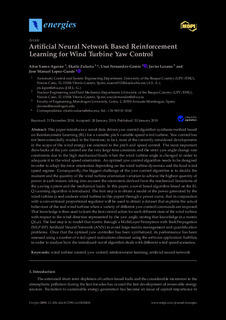| dc.rights.license | Attribution-NonCommercial-NoDerivatives 4.0 International | * |
| dc.contributor.author | Lozano Silva, Javier | |
| dc.contributor.other | Saenz Aguirre, Aitor | |
| dc.contributor.other | Zulueta, Ekaitz | |
| dc.contributor.other | Fernandez Gamiz, Unai | |
| dc.contributor.other | Lopez-Guede, Jose Manuel | |
| dc.date.accessioned | 2019-02-19T09:26:20Z | |
| dc.date.available | 2019-02-19T09:26:20Z | |
| dc.date.issued | 2019 | |
| dc.identifier.issn | 1996-1073 | eu_ES |
| dc.identifier.other | https://katalogoa.mondragon.edu/janium-bin/janium_login_opac.pl?find&ficha_no=150163 | eu_ES |
| dc.identifier.uri | https://hdl.handle.net/20.500.11984/1166 | |
| dc.description.abstract | This paper introduces a novel data driven yaw control algorithm synthesis method based on Reinforcement Learning (RL) for a variable pitch variable speed wind turbine. Yaw control has not been extendedly studied in the literature; in fact, most of the currently considered developments in the scope of the wind energy are oriented to the pitch and speed control. The most important drawbacks of the yaw control are the very large time constants and the strict yaw angle change rate constraints due to the high mechanical loads when the wind turbine angle is changed in order to adequate it to the wind speed orientation. An optimal yaw control algorithm needs to be designed in order to adapt the rotor orientation depending on the wind turbine dynamics and the local wind speed regime. Consequently, the biggest challenge of the yaw control algorithm is to decide the moment and the quantity of the wind turbine orientation variation to achieve the highest quantity of power at each instant, taking into account the constraints derived from the mechanical limitations of the yawing system and the mechanical loads. In this paper, a novel based algorithm based on the RL Q-Learning algorithm is introduced. The first step is to obtain a model of the power generated by the wind turbine (a real onshore wind turbine in this paper) through a power curve, that in conjunction with a conventional proportional regulator will be used to obtain a dataset that explains the actual behaviour of the real wind turbine when a variety of different yaw control commands are imposed. That knowledge is then used to learn the best control action for each different state of the wind turbine with respect to the wind direction represented by the yaw angle, storing that knowledge in a matrix Q(s,a). The last step is to model that matrix through a MultiLayer Perceptron with BackPropagation (MLP-BP) Artificial Neural Network (ANN) to avoid large matrix management and quantification problems. Once that the optimal yaw controller has been synthetized, its performance has been assessed using a number of wind speed realizations obtained using the software application TurbSim, in order to analyze how the introduced novel algorithm deals with different wind speed scenarios. | eu_ES |
| dc.language.iso | eng | eu_ES |
| dc.publisher | MDPI AG | eu_ES |
| dc.rights | © 2019 by the authors | eu_ES |
| dc.rights.uri | http://creativecommons.org/licenses/by-nc-nd/4.0/ | * |
| dc.subject | wind turbine control | eu_ES |
| dc.subject | yaw control | eu_ES |
| dc.subject | reinforcement learning | eu_ES |
| dc.subject | artificial neural network | eu_ES |
| dc.title | Artificial Neural Network Based Reinforcement Learning for Wind Turbine Yaw Control | eu_ES |
| dc.type | http://purl.org/coar/resource_type/c_6501 | |
| dcterms.accessRights | http://purl.org/coar/access_right/c_abf2 | eu_ES |
| dcterms.source | Energies | eu_ES |
| local.contributor.group | Análisis de datos y ciberseguridad | eu_ES |
| local.description.peerreviewed | true | eu_ES |
| local.identifier.doi | http://dx.doi.org/10.3390/en12030436 | eu_ES |
| local.rights.publicationfee | APC | |
| local.rights.publicationfeeamount | 1655 EUR | |
| local.source.details | Vol. 12. Nº 3. Special Issue 10 Years Energies - Horizon 2028). 436, 2019 | eu_ES |
| oaire.format.mimetype | application/pdf | |
| oaire.file | $DSPACE\assetstore | |
| oaire.resourceType | http://purl.org/coar/resource_type/c_6501 | eu_ES |
| oaire.version | http://purl.org/coar/version/c_970fb48d4fbd8a85 | eu_ES |








